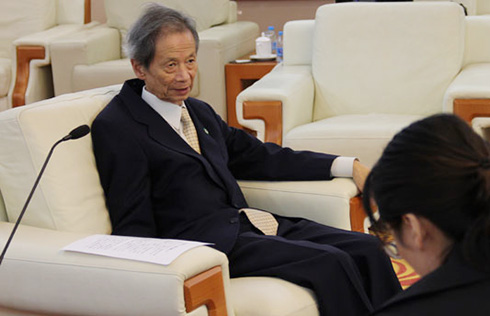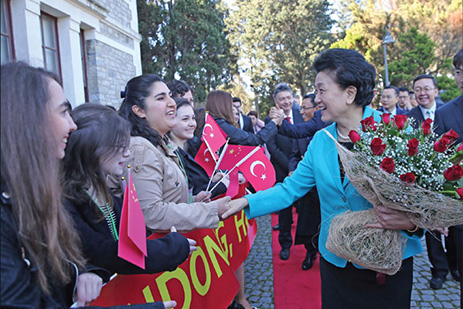Han treasures bring kings to life
 |
|
Willow Weilan Hai, China Institute Gallery director, introduces a jade burial suite at the exhibition Dream of the Kings: A Jade Suit for Eternity, Treasures of the Han Dynasty from Xuzhou. Hong Xiao / China Daily |
A burial suit made of thousands of pieces of jade laced together with gold thread and designed to protect and glorify a king in his afterlife will go on display in New York city. The exhibition - Dream of the Kings: A Jade Suit for Eternity, Treasures of the Han Dynasty from Xuzhou - features more than 76 objects from royal tombs of the Western Han Dynasty (206 BC - 8 AD) and will be on display in the US for the first time from May 25 to Nov 12 at the China Institute Gallery. Ranging from terracotta performers to carved stone animals, the objects are an extraordinary testimony to the customs and beliefs surrounding life and death during the Western Han - one of China's "golden eras".
In 201 BC, the first emperor of the Han Dynasty anointed his younger brother the first king of the Chu Kingdom, which was centered in Peng Cheng (Xuzhou today), in southeast China's Jiangsu province.
Ruling under the emperor's protection and given special exemption from imperial taxes, the elite of this realm enjoyed a lavish lifestyle.
Twelve generations of kings lived, died and were buried in sumptuous tombs carved into the nearby rocky hills.
Although many of the tombs were looted over the years, numerous treasures were discovered in later excavations telling the story of the Chu kings' affluence, as well as their beliefs in immortality and the afterlife.
The exhibition is divided into four sections: The King's Guards, Dreams of Eternity, Rapt by Jade and Life in the Afterlife.
Dreams of Eternity highlights one of the most stunning finds - an elaborate jade burial suit, assembled from thousands of pieces of jade, the precious stone prized by the Chinese since the Neolithic times as an auspicious material that could ensure immortality.
The suit, which was excavated in 1994 in Peng Cheng, consists of 4,248 tiles, more than any other jade suit discovered to date.
One of the earliest ever made (circa 175 BC), it is bound with a rare gold thread, signifying the highest of ranks.
According to excavated records from the tombs, only kings and queens of the Chu rated jade suits with gold thread for their afterlife garb. The material on display is known as Hetian Jade, one the rarest forms of the gemstone. "People during the Han Dynasty regarded death as birth and longed for immortality," said Willow Weilan Hai, director of China Institute Gallery.
"To prepare for the afterlife, they constructed their tombs to be eternal residences. The exhibition is a rare window into the extraordinarily accomplished Han civilization through these remarkable objects of the highest artistry," said Hai. The exhibition has been in preparation for nearly ten years. "We are most grateful to the Xuzhou Museum," said Hai.
Established in 1959, the Xuzhou Museum is known for its exceptional collection of Han dynasty artifacts. "In Chinese history of thousands of years, Han is a glorious historical period, which started from Xuzhou," Hai said. "Xuzhou is the birthplace of the first emperor of the Han Dynasty, and all the beautiful artworks in this exhibition are from his birthplace."
"The culture of the Han Dynasty has a far-reaching effect even on the world's history," said Li Yinde, director emeritus of the Xuzhou Museum and curator of the exhibition. He said the Han Dynasty was experiencing something of a renaissance in 2017. Two related exhibitions are on view concurrently in the US: Tomb Treasures: New Discoveries from China's Han Dynasty at the Asian Art Museum in San Francisco from Feb 17 to May 28, and Age of Empires: Chinese Art of the Qin & Han Dynasties (221 BC-AD 220) at the Metropolitan Museum of Art in New York from April 3 to July 16.
The Dream of Kings exhibition will travel to the Nelson-Atkins Museum of Art in Kansas City, Missouri, in December and stay on display through April 2018.
xiaohong@chinadailyusa.com




















